Abstract
This study investigated the effect of grinding media on the fine-grinding performance in the wet tumbling mill. Comparative experiments between cylpebs and ceramic balls were conducted in a laboratory wet ball mill under various conditions, such as different total masses, total surface areas, and total numbers. The results indicated that ceramic balls produce a slightly smaller instantaneous breakage rate than cylpebs due to their small bulk density at the same charge volume. However, a larger instantaneous breakage rate can be obtained by ceramic balls with the same total mass due to the larger surface area. According to experiments related to the total surface area and total number of ceramic balls, it was found that the fine grinding of ceramic balls also needs to meet a certain break force, which is mainly determined by the diameter of the ceramic balls. Moreover, two models were developed to use ceramic balls instead of cylpebs as fine-grinding media in the wet tumbling mill based on the ball size and the ratio of the total mass of cylpebs. Cylpebs can be replaced by ceramic balls with 1.16–1.75 times the diameter of cylpebs, taking up only 76%–83% of the total weight of cylpebs. When the charge volume of cylpebs is between 20% and 35% in the wet ball mill, cylpebs can be replaced by ceramic balls of the same single mass, with the total weight of the ceramic balls being only 74%–77% of that of the cylpebs.
1. Introduction
In mineral-processing plants, grinding is a process of particle size reduction that consumes a large amount of energy: about 50% of the total energy consumption in comminution []. Therefore, enhancing the energy efficiency in the grinding process helps to save the operation cost of the concentrator.
In order to improve the energy efficiency in the grinding process of tumbling mills, many researchers have studied the effect of different operating conditions on the energy efficiency of existing tumbling mills [,]. The grinding media have been reported to be a critical parameter in the grinding process of tumbling mills. Because the types of grinding media have an important effect on the product size distribution and the cost of the grinding operation due to energy and media consumption, balls and rods, as traditional grinding media, have been widely used in tumbling mills [,]. Other types of grinding media, including cylpebs [,,], hexagons [], pebbles [,], worn balls [,], and ceramic balls [], have also been studied by many researchers. The significant influence of the types of grinding media on the grinding performance in terms of the loading behavior [,], contact mechanism [], grinding kinetics [,], and mill powder [] has been reported in detail by Shahbazi et al. []. Cylpebs with a greater surface area have been used as fine-grinding media in the mineral [] and cement clinker [] industries. Shi [] reported that, with cylpebs as grinding media, the product size distribution showed slightly less oversize but the same fine size compared with balls with the same specific energy, which may be because cylpebs have a larger surface area than steel balls. Other researchers have also found that cylpebs have a faster breakage rate than balls with the same total mass [,]. Pebbles can be used as grinding media in stirred mills [,] and tumbling mills [,]. Research has shown that it saves 25% steel and 15% energy in consumption by adding a 25% volume ratio of pebbles instead of steel balls as the grinding media in the secondary grinding mill. Ceramic balls are usually used as fine-grinding media in vertical stirred mills for regrinding []. In recent years, ceramic balls have reportedly been applied in secondary overflow ball mills by our research group for feed particle sizes of −0.5 mm, which, compared with cylpebs, saves 38.5% energy in the industry. In addition, ceramic balls have better wear resistance than cylpebs. Under the condition that the grinding throughput is satisfied, the consumption of ceramic balls is only 40% of that of cylpebs [].
An analysis of the influence of ceramic balls and cylpebs on the fine-grinding performance proves that the energy saving of the wet tumbling mill is necessary. However, the effect of ceramic balls and cylpebs on the fine-grinding performance of wet tumbling mills has not yet been systematically studied. The main purpose of this study was to compare the differences in the fine-grinding performance between ceramic balls and cylpebs in a laboratory batch wet ball mill. In addition, a new method of replacing cylpebs with ceramic balls as grinding media in the tumbling mill based on the ball size and the ratio of the total mass is presented.
2. Theoretical Background
The comminution process is satisfactorily described using the grinding kinetics approach. The population balance model (PBM) has been widely used to describe the particle breakage behavior in the ball mill [,]. The population balance model includes two functions: the breakage-rate function (Si) and the breakage-distribution function (bij). The two parameters can be obtained from batch grinding tests with monosize-fraction feed. The breakage-rate function (S1) for the top size can be expressed as follows:
where S1(t) is the breakage rate for the top size; ω1 is the weight fraction of the material with the top size; t is the grinding time (min). If the breakage rate (S1(t)) does not change with time and follows the first-order kinetics, Equation (2) can be given in the following form:
Gupta [] found that the actual specific breakage rate (S1) for different grinding-time intervals is defined as follows:
If the breakage follows the first-order grinding kinetics, then the instantaneous breakage rate (S1) for different grinding-time intervals can be presented as follows:
The ball size is a critical parameter that affects the breakage rate and grinding performance. The relationship between the maximum ball size (D) and maximum particle size (Xm) has been investigated by various researchers [,,,,]:
where k is a constant, and the value of k is 1.25 × 10−3 in Kelsall (1965) studies [].
In this study, the maximum particle size was 0.15 mm, which was calculated by substituting the constant of Kelsall into Equation (5), and the diameter of the steel ball was 10.95 mm. Consequently, a diameter close to 11 mm was selected as a follow-up reference. In order to meet the requirements of the breakage force, the sizes of the cylpebs and ceramic balls with the same quality as 11 mm steel balls were 10 × 10 mm and 14 mm, respectively. According to Equation (5), the constants (k) of the cylpebs and ceramic balls were 1.5 × 10−3 and 0.77 × 10−3, respectively.
3. Materials and Methods
3.1. Materials
The tested samples, tungsten ores, were taken from the underflow of the industrial second-stage classification in Shizhuyuan Nonferrous Metal Co., Chenzhou, China. The XRD analysis of tungsten ores in Figure 1 shows that scheelite, wolframite, molybdenite, bismuthinite, fluorite, and hematite are valuable minerals, and quartz is mainly gangue. The chemical compositions of the tungsten ores analyzed by XRF are presented in Table 1, which indicates that WO3 (0.279), Mo (0.066), Bi (0.110), Fe2O3 (14.130), and CaO (28.320) are the main valuable elements, and SiO2 is the main impurity.

Figure 1.
XRD analysis of tungsten ores.

Table 1.
Chemical compositions of tungsten ores (wt/%).
3.2. Grinding Media
Cylpebs and ceramic balls were used in the experiments performed to determine the effect of the grinding media. To be more specific, the grinding media used for the experiments were cylpebs sized 14 × 16 mm, 12 × 12 mm, and 10 × 10 mm, provided by Goldpro New Material Co., Ltd., Handan, China, and ceramic balls with diameters of 25 mm, 21 mm, 17 mm, 15 mm, 14 mm, and 10 mm, manufactured by Betterwear New Material Co., Ltd., Jingdezhen, China. The compositions and physical properties of the cylpebs and ceramic balls used in the experiments are presented in Table 2 and Table 3, respectively. The photographs of the grinding media used are shown in Figure 2.

Table 2.
Composition properties of grinding media.

Table 3.
Physical properties of grinding media.
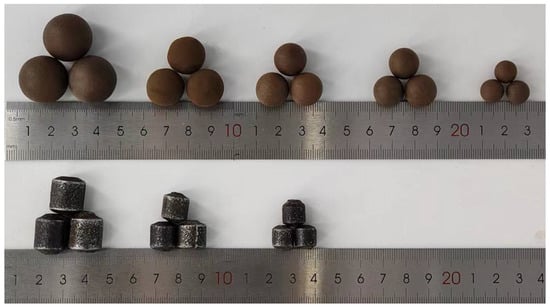
Figure 2.
Photographs of the grinding media.
3.3. Experimental Methods
3.3.1. Media Charge Conditions
The media mass, media surface area, and number of media were used as the media charge conditions to compare the differences in the fine-grinding performance between cylpebs and ceramic balls.
Table 4, Table 5 and Table 6, Table 7 present the media conditions when the charge volume (22.5%), total mass, total surface area, and total number of media are kept the same, respectively.

Table 4.
Ceramic balls and cylpebs with the same charge volume (%).

Table 5.
Ceramic balls with the same total mass as cylpebs (12 × 12 mm).

Table 6.
Ceramic balls with the same total number as cylpebs (12 × 12 mm).

Table 7.
Ceramic balls with the same total surface area as cylpebs (12 × 12 mm).
Table 4 presents the media charge-volume conditions, which were used as the base case for the comparison. Table 5 presents the ceramic balls’ charge with the same total mass as 12 × 12 mm cylpebs. Table 6 presents ceramic balls with the same total number as 12 × 12 mm cylpebs. Table 7 presents the ceramic balls’ charge with the same total surface area but less total mass than that of the 12 × 12 mm cylpebs. Table 8 presents the media conditions’ change with the charge volume.

Table 8.
Comparison of ceramic balls and cylpebs with different charge volumes.
3.3.2. Experimental Details
This experiment was carried out in a small-scale laboratory mill with a size of 90 mm × 132 mm, a volume of 2000 cm3, and a set speed of 170 rev/min. In each test, 200 g of −0.15 + 0.075 mm single-sized feed was used, and a volume of 100 mL of tap water was then added to the mill charge in order to make a 67 wt.% solids concentration. The illustration of the grinding equipment between the rolls is shown in Figure 3.
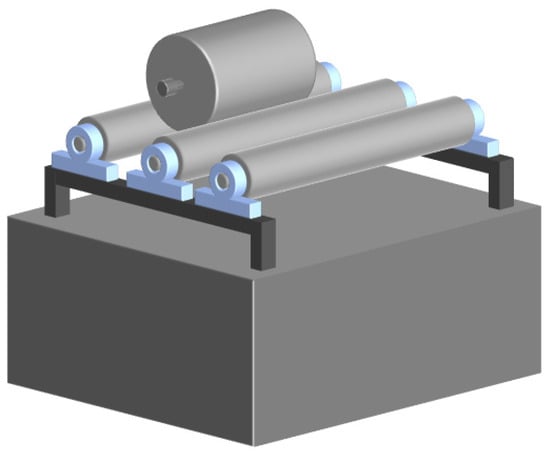
Figure 3.
Schematic of grinding equipment used in the grinding process.
Afterward, the ground products under various conditions were sieved using a Taylor standard sieve set ranging from 0.075 mm to 0.038 mm. In the case of wet screening, the weight of the product after sieving for 1 min was less than 1% of the original screening weight. Finally, the data were processed in batches by Excel to obtain the particle-size-distribution data of the final grinding product.
In order to verify that the breakage behavior follows the first-order kinetics, first, in the comparative experiments between 17 mm ceramic balls and 12 × 12 mm cylpebs under the same charge volume, the ceramic balls and cylpebs were first ground for 2, 4, and 6 min. Then, the comparative experiments of the total surface area, number, and mass of ceramic balls were conducted, with the grinding time of the other sizes of ceramic balls and cylpebs kept at 2 min.
In order to determine that ceramic balls have the same fine-grinding performance as cylpebs within the range of the charge volume, 17 mm ceramic balls and 12 × 12 mm cylpebs were selected as the grinding media. The mass of the tested sample, the solids concentration, and the grinding time were kept constant with comparative tests.
4. Results and Discussion
4.1. The Effect of the Media Size on the Fine Grinding of Tungsten Ores
Figure 4 shows the first-order plots for the −0.15 + 0.075 mm feed size of tungsten ores ground by 12 × 12 mm cylpebs and 17 mm ceramic balls at the same charge volume of 22.5%. R2 is the statistical term for the correlation coefficient, which provides a measure of how well the observed outcomes are replicated by the regression model. When R2 = 1, this indicates that the two sets of data are exactly matched. As is shown in Figure 4, the R2 for 12 × 12 mm cylpebs and 17 mm ceramic balls are 0.992 and 0.995, respectively, both of which are close to 1, which indicates that the breakage of the −0.15 + 0.075 mm single-sized feed generally follows the first-order grinding kinetics, and the value of the Si can be determined by the slope of the straight line of the first-order plots. The specific breakage rates of cylpebs and ceramic balls, calculated by Equations (2) and (4), are presented in Table 9.
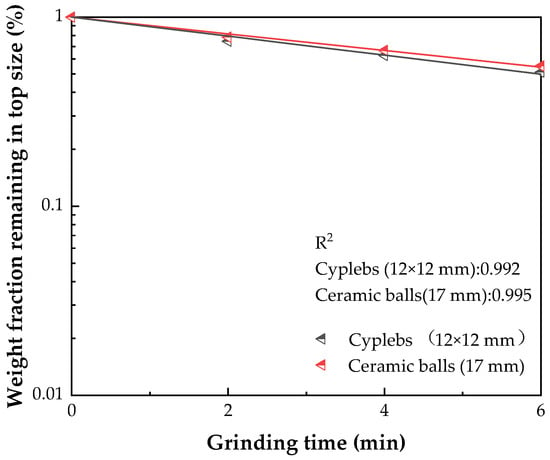
Figure 4.
The first-order plots for cylpebs and ceramic balls at the same charge volume.

Table 9.
A comparison of the specific breakage rates between Equations (2) and (4).
As shown in Table 9, the calculation results of Equations (2) and (4) share the same pattern, presenting that the specific breakage rate of cylpebs is greater than that of ceramic balls under the same charge volume (22.5%). Therefore, the instantaneous breakage rate can be used to compare the fine-grinding performance of cylpebs and ceramic balls, thus simplifying the experiment process.
The instantaneous breakage rate of ceramic balls was compared with that of cylpebs at the same charge volume, as shown in Figure 5, which shows that the instantaneous breakage rate of ceramic balls of all sizes is smaller than that of cylpebs. The instantaneous breakage rate obtained by using ceramic balls at grinding periods of 2 min is smaller than that obtained by using cylpebs in all cases. This may reflect the fact that ceramic balls have less total mass than cylpebs under the same charge volume. Therefore, the total impact force of ceramic balls is inferior to that of cylpebs.
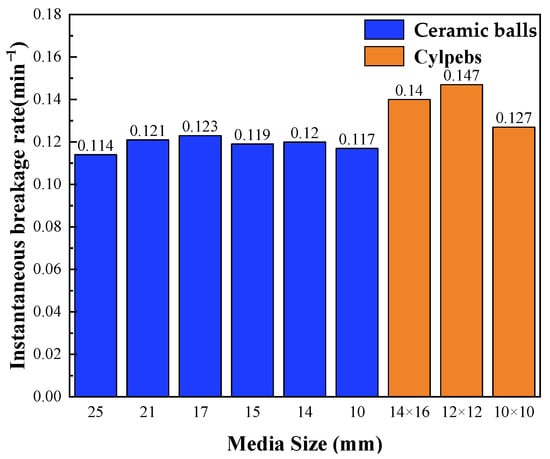
Figure 5.
Instantaneous breakage rates of the grinding media at the same charge volume.
In addition, an interesting observation in Figure 5 is that when the diameter of ceramic balls is larger than 17 mm, the instantaneous breakage rate is less than that produced by using 17 mm ceramic balls. The single masses of the 25 mm and 21 mm ceramic balls are larger than that of the 17 mm ceramic balls, which means that the larger the balls, the larger the impact break force, and few numbers of balls are used for the break, which means that the probability of collision is smaller. On the premise of meeting the break force, the smaller the impact force, the larger the number of balls applied to the break, and the better the fine-grinding performance. It was also observed that when the diameter of ceramic balls is less than 14 mm, although the number and surface area of the 10 mm ceramic balls are larger than those of the 14 mm ceramic balls, the break force is insufficient, and thus the fine-grinding performance will be weakened. In general, 12 × 12 mm cylpebs have the best grinding effect among cylpebs, and 17 mm ceramic balls have the best grinding effect among ceramic balls for grinding −0.15 + 0.075 mm tungsten ores.
4.2. The Effect of the Total Mass of Media on the Fine Grinding of Tungsten Ores
In order to deeply investigate the differences in the fine-grinding performance between ceramic balls and cylpebs, batch grinding tests using ceramic balls with the same total mass as 12 × 12 mm cylpebs were conducted. The instantaneous specific breakage rates of the ground products are shown in Figure 6.
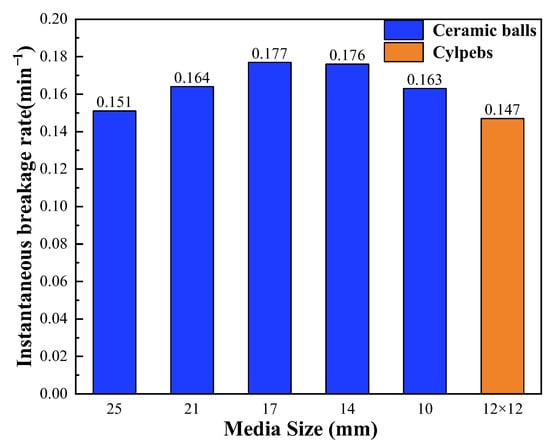
Figure 6.
Instantaneous breakage rates of the ground products at the same total mass.
Compared with 12 × 12 mm cylpebs, 17 mm ceramic balls have the same single mass, total number of grinding media, and total mass, but a larger total surface area. As illustrated in Figure 6, the instantaneous breakage rate (0.177 min−1) of 17 mm ceramic balls is larger than that (0.147 min−1) of 12 × 12 mm cylpebs. This may reflect the fact that ceramic balls have a larger total surface area than cylpebs, which is beneficial to fine grinding with the same total charge mass and same total number of charges.
Compared with 12 × 12 mm cylpebs, 21 mm ceramic balls have the same total mass, larger total surface area, larger single mass, and smaller total number of charges. As shown in Figure 6, the instantaneous breakage rate (0.164 min−1) of 21 mm ceramic balls is still larger than that of 12 × 12 mm cylpebs. According to Table 5, there are 0.54 times less total number, 1.07 times larger total surface area, and 1.84 times larger single mass than 12 × 12 mm cylpebs, which is also beneficial to fine grinding at the same total charge mass. However, when the size of the ceramic ball continues to increase to 25 mm, the instantaneous breakage rate (0.151 min−1) of 25 mm ceramic balls is more than that of 12 × 12 mm cylpebs. The weight of one single 25 mm ceramic ball is 3.15 times heavier than that of 12 × 12 mm cylpebs, which also shows that the impact break force of ceramic balls is greater than that of cylpebs, and the total number and total surface area of 25 mm ceramic balls are only 0.32 times and 0.92 times smaller, respectively, than those of 12 × 12 mm cylpebs.
When the size of the ceramic ball continues to decrease to 14 mm, the instantaneous breakage rate (0.176 min−1) of 14 mm ceramic balls is larger than that of 12 × 12 mm cylpebs. Although the weight of one single 14 mm ceramic ball is only 0.58 times lighter than that of 12 × 12 mm cylpebs, the total number and total surface area of 14 mm ceramic balls are 1.73 times and 1.57 times larger, respectively, than those of 12 × 12 mm cylpebs. When the size of the ceramic ball continues to decrease to 10 mm, the instantaneous breakage rate (0.163 min−1) of 10 mm ceramic balls is more than that of 12 × 12 mm cylpebs. Although the weight of one single 10 mm ceramic ball is 0.22 times lighter than that of 12 × 12 mm cylpebs, the total number of 10 mm ceramic balls is 4.64 times more than that of 12 × 12 mm cylpebs, and the total surface area is 2.15 times larger than that of 12 × 12 mm cylpebs.
Therefore, it is submitted that, in the process of fine grinding, the impact break force does not need to be too large, and a larger surface area and greater number of media could be more conducive to fine grinding.
4.3. The Effect of the Total Number of Media on the Fine Grinding of Tungsten Ores
Because the bulk density of the ceramic balls was only 2.2 g/cm3, when the 17 mm ceramic balls (single mass equal to 12 × 12 mm cylpebs) with the same total mass were used, the charge volume reached 45%. Considering that the charge volume in the ball mill is generally not higher than 50%, the diameter of 17 mm was selected as the maximum ceramic-ball size used in the experiment to compare with 12 × 12 mm cylpebs of the same total number. Figure 7 shows the effect of the total number of ceramic balls on the particle size distributions and instantaneous breakage rates of the ground products. When the size of ceramic balls is less than 17 mm, despite having the same total number of grinding media, a smaller charge mass and total surface area could lead to a poorer fine-grinding performance. Therefore, the instantaneous breakage rate of the ground product using 14 mm or 10 mm ceramic balls as the grinding media is less than that of 12 × 12 mm cylpebs. Despite having the same total number as cylpebs, only when ceramic balls have the same single mass as cylpebs can an equal fine-grinding performance be achieved.
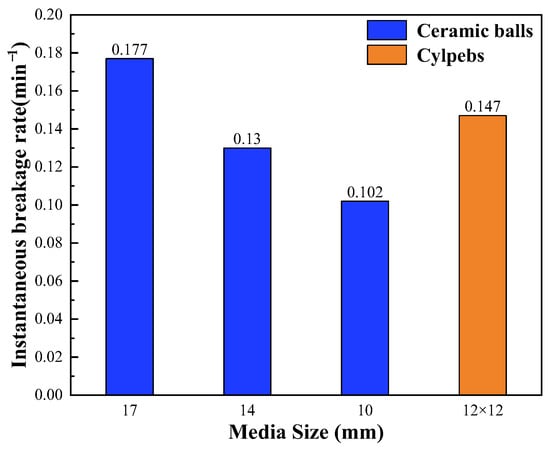
Figure 7.
Instantaneous breakage rates of the ground products at the same total number.
4.4. The Effect of the Total Surface Area of Media on the Fine Grinding of Tungsten Ores
The effect of the total surface area on the fine-grinding performance is shown in Figure 8. As presented in Table 4 and Table 7, 17 mm ceramic balls have the same total surface area, but 0.75 times less the total number of charges and total mass compared with 12 × 12 mm cylpebs. Moreover, Figure 8 shows that, when the 17 mm ceramic balls shared the same total surface area as 12 × 12 mm cylpebs, an equal instantaneous breakage rate of the ground product could be obtained. This interesting phenomenon may indicate that, when using ceramic balls with an equal single mass instead of cylpebs, the total mass of the ceramic balls can be less than that of the cylpebs. When the size of the ceramic ball is larger than 17 mm and up to 21 mm, the instantaneous breakage rate of the ground product is larger than that produced by 12 × 12 mm cylpebs. This is because, when the total surface area is kept the same, the weight of a single 21 mm ceramic ball is 1.84 times heavier than that of 12 × 12 mm cylpebs, and, hence, the break force of 21 mm ceramic balls is greater than that of 12 × 12 mm cylpebs. Although the total number of 21 mm ceramic balls is only 0.49 times smaller than that of 12 × 12 mm cylpebs, which also shows that a larger break force makes up for the lack of collision probability, the former still demonstrates a better effect of the fine grinding. When the size of ceramic balls is less than 17 mm, despite having the same total surface area and a larger total number, the single mass and total mass are both less than those of 12 × 12 mm cylpebs. Therefore, the effect of the fine grinding of 14 mm and 10 mm ceramic balls is inferior to that of 12 × 12 mm cylpebs.
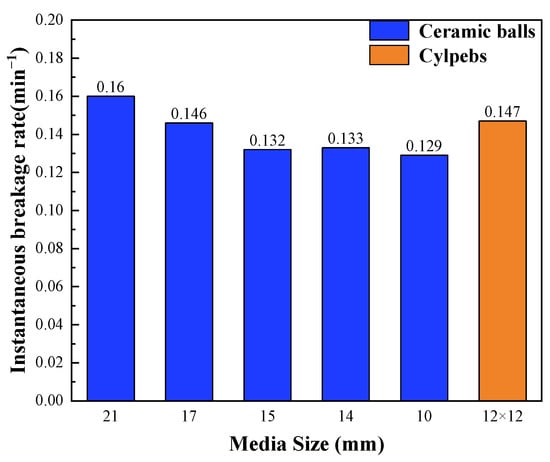
Figure 8.
Instantaneous breakage rates of the ground products at the same total surface area.
4.5. The Overall Relationship between the Optimum Composition and Various Parameters
It was shown that the optimum fine-grinding performance of the wet ball mill was indeed affected by various parameters. The three most sensitive parameters of the ceramic balls are the total mass, total surface area, and total number. Figure 9 shows the effects of three different parameters of the ceramic balls (the total mass, total surface area, total number) on the distribution of the percentage passing 0.075 mm in the ground product. It was observed that the distribution of the percentage passing 0.075 mm first increased till the size of the ceramic balls reached 17 mm, and then decreased with the rise in the size of the ceramic balls. It also shows that 17 mm ceramic balls have the best effect of fine grinding for feed sized −0.15 + 0.075 mm. As shown in Figure 9a, the distribution of the percentage passing 0.075 mm in the ground product increased with the total mass when the charge volume of the ceramic balls was less than 50%. When the total mass of the ceramic balls reached 2000 g, the ceramic balls performed the best in fine grinding. As presented in Figure 9b, the distribution of the percentage passing 0.075 mm in the ground product first increased with the total surface area till the latter reached 1900 cm2, and it then started to decrease. This is mainly because the total surface area of 10 mm ceramic balls is larger than that of cylpebs when the total mass of the two is the same, but the break force of the former is insufficient, which weakens its effect of fine grinding. From Figure 9c, it is observed that the distribution of the percentage passing 0.075 mm in the ground product increased as the total number of ceramic balls went up when using ceramic balls of a uniform size. When the size of the ceramic balls is between 14 and 21 mm, only a moderate total number of ceramic balls is used, which also suggests that the total number of ceramic balls is not the more the better. This should be considered, together with the size of the ceramic balls, to find the best condition for fine grinding.
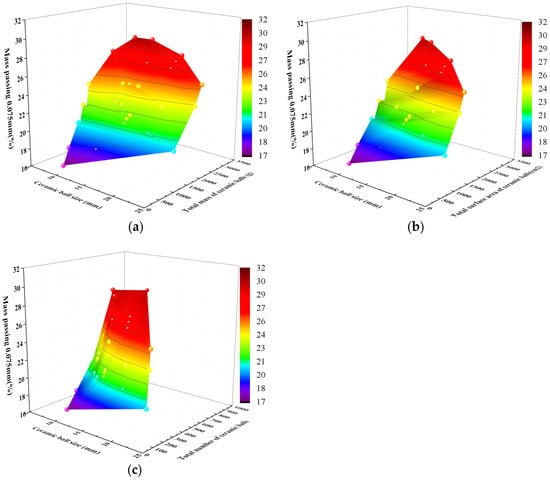
Figure 9.
The effects of different parameters on the fine-grinding performance: (a) total mass of ceramic balls; (b) total surface area of ceramic balls; (c) total number of ceramic balls.
In general, the fine-grinding performance of ceramic balls is mainly determined by the total mass and the size of the ceramic balls. When the size of the ceramic balls remains the same, the total surface area, charge volume, and total number increase with the increase in the total mass. When the total mass is constant, the total surface area and total number of ceramic balls change with the size of the ceramic balls.
4.6. A New Approach to Using Ceramic Balls Instead of Cylpebs as Fine-Grinding Media
In Section 4.1 and Section 4.5, it is shown that 14–21 mm ceramic balls and 12 × 12 mm cylpebs have better performances of the fine-grinding process. However, because the bulk specific gravity of ceramic balls is only 0.5 times that of cylpebs, the fine-grinding performance of ceramic balls is inferior to that of cylpebs at the same charge volume. In order to yield the same fine-grinding performance achieved by cylpebs in the wet ball mill, we proposed a method using ceramic balls instead of cylpebs under the premise that the ceramic balls would reach a certain total mass and size. The relationship between the distribution of the percentage passing 0.075 mm and the ratio of the total mass of cylpebs can be defined as follows:
where y is the distribution of the percentage passing 0.075 mm in the ground product; x is the ratio of the total mass of 12 × 12 mm cylpebs; k and b are the slope and intercept of the fitting line, respectively. The size of ceramic balls can be calculated as follows:
where D is the maximum ball size (mm), Xm is the maximum particle size (mm), and k1 is a constant for ceramic balls. In this study, 14–21 mm ceramic balls were suitable for fine grinding in the mill. Therefore, the k1 is 0.34 × 10−3~0.77 × 10−3.
As shown in Figure 10a, when the distribution of the percentage passing 0.075 mm of 21 mm ceramic balls is the same as that of 12 × 12 mm cylpebs (25.41%), the total mass of the 21 mm ceramic balls is only 0.83 times that of the 12 × 12 mm cylpebs. In Figure 10b, when the distribution of the percentage passing 0.075 mm of the 17 mm ceramic balls is the same as that of the 12 × 12 mm cylpebs (25.41%), the total mass of the 17 mm ceramic balls is only 0.76 times that of the 12 × 12 mm cylpebs. Moreover, in Figure 10c, when the distribution of the percentage passing 0.075 mm of the 14 mm ceramic balls is the same as that of the 12 × 12 mm cylpebs (25.41%), the total mass of the 14 mm ceramic balls is only 0.77 times that of the 12 × 12 mm cylpebs.

Figure 10.
The relationship of the distribution of the percentage passing 0.075 mm in the ground product and the ratio of the total mass of 12 × 12 mm cylpebs at the same charge volume: (a) 21 mm ceramic balls; (b) 17 mm ceramic balls; (c) 14 mm ceramic balls.
Therefore, when the fine-grinding performance is the same, less total weight is required compared with cylpebs due to the larger total surface area of ceramic balls, which explains the reason why ceramic balls could save more energy than cylpebs in second-stage fine grinding in industrial applications [].
Because the charge volume of ball mills is usually below 50%, in order to prompt a better replacement of cylpebs with ceramic balls as the fine-grinding media, we carried out expanded research on the charge volume and found a suitable charge-volume range.
As shown in Figure 11a, when compared with the 20% charge volume of 12 × 12 mm cylpebs, for 17 mm ceramic balls to have the same grinding performance, it only requires that the ratio of the total mass of ceramic balls to cylpebs be 0.75:1, and a charge volume larger than 30% (1.5 times that of 12 × 12 mm cylpebs). In Figure 11b, when compared with the 25% charge volume of 12 × 12 mm cylpebs, it only demands that the ratio of the mass of ceramic balls to cylpebs be 0.77:1, and a charge volume larger than 38.5% (1.54 times that of 12 × 12 mm cylpebs). In Figure 11c, when compared with the 30% charge volume of 12 × 12 mm cylpebs, it only requires that the ratio of the mass of ceramic balls to cylpebs be 0.74:1, and a charge volume larger than 44.4% (1.48 times that of 12 × 12 mm cylpebs). In Figure 11d, when compared with the 35% charge volume of 12 × 12 mm cylpebs, it only requires that the ratio of the mass of ceramic balls to cylpebs be 0.76:1, and a charge volume larger than 53.2% (1.52 times that of 12 × 12 mm cylpebs).
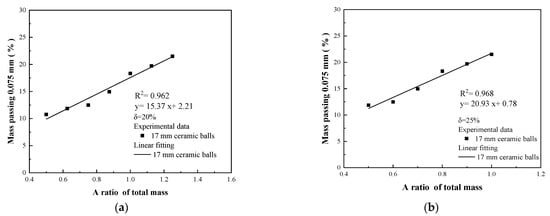
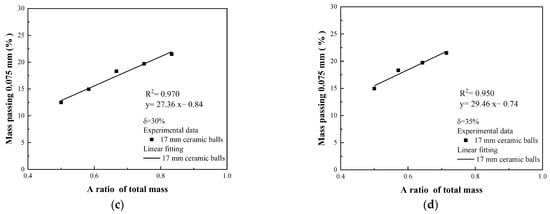
Figure 11.
The relationship of the distribution of the percentage passing 0.075 mm in the ground product and the ratio of the total mass of 12 × 12 mm cylpebs in a wider charge volume: (a) δ= 20%; (b) δ= 25%; (c) δ = 30%; (d) δ = 35%.
As a result, for fine grinding in the wet ball mill, when the charge volume of cylpebs is 20%–35%, cylpebs can be replaced by ceramic balls of the same single mass. In this case, the total mass of ceramic balls is only about 0.74–0.77 times that of cylpebs.
5. Conclusions
This study investigated the fine-grinding performance of ceramic balls in comparison with cylpebs. According to the test data, the fine-grinding performance is mainly dependent on the ball size and total mass. The single mass of ceramic balls is 0.58–1.84 times that of cylpebs, and the size of ceramic balls is 1.07–1.5 times that of cylpebs. Due to the larger surface area of ceramic balls, the same grinding performance can be obtained only when the total mass of ceramic balls is 0.76–0.83 times that of cylpebs. An innovative approach for using ceramic balls instead of cylpebs as grinding media in the wet ball mill based on the ball size and the ratio of the total mass of cylpebs was proposed. Therefore, ceramic balls can be used in wet tumbling mills to replace cylpebs as fine-grinding media. This result has also been verified in industrial applications. It should be noted that this new method requires further verification with different feed sizes and media.
Author Contributions
Conceptualization, N.L. and C.W.; methodology, N.L.; validation, J.L., Y.L. and X.F.; formal analysis, J.L.; investigation, N.L.; data curation, J.L.; writing—original draft preparation, N.L.; writing—review and editing, C.W.; resources, Z.Z.; supervision, funding acquisition, C.W. and W.Y. All authors have read and agreed to the published version of the manuscript.
Funding
This work was financially supported by the Projects of the National Natural Science Foundation of China (grant number 51964016), and the Industrial Innovation and Entrepreneurship Team of Hebei Province, China (grant number 215A7606D).
Acknowledgments
The authors would also like to thank the Jiangxi Key Laboratory of Mining Engineering and Hunan Shizhuyuan Nonferrous Metals Co., Ltd., China, for their support. Yuqing Wang from the Jiangxi University of Science and Technology is also gratefully acknowledged.
Conflicts of Interest
The authors declare no conflict of interest.
References
- Jeswiet, J.; Szekeres, A. Energy Consumption in Mining Comminution. Procedia CIRP 2016, 48, 140–145. [Google Scholar] [CrossRef]
- Cuhadaroglu, D.; Samanli, S.; Kizgut, S. The Effect of Grinding Media Shape on the Specific Rate of Breakage. Part. Part. Syst. Charact. 2008, 25, 465–473. [Google Scholar] [CrossRef]
- Oner, M. Ball Size Rationing Affects Clinker Grinding. World Cem. Res. 1999, 30, 101–106. [Google Scholar]
- Li, C.; Gao, Z. Effect of grinding media on the surface property and flotation behavior of scheelite particles. Powder Technol. 2017, 322, 386–392. [Google Scholar] [CrossRef]
- Corin, K.; Song, Z.; Wiese, J.; O’Connor, C. Effect of using different grinding media on the flotation of a base metal sulphide ore. Miner. Eng. 2018, 126, 24–27. [Google Scholar] [CrossRef]
- Shi, F. Comparison of grinding media—Cylpebs versus balls. Miner. Eng. 2004, 17, 1259–1268. [Google Scholar] [CrossRef]
- Ipek, H. The effects of grinding media shape on breakage rate. Miner. Eng. 2006, 19, 91–93. [Google Scholar] [CrossRef]
- Qian, H.Y.; Kong, Q.G.; Zhang, B.L. The effects of grinding media shapes on the grinding kinetics of cement clinker in ball mill. Powder Technol. 2013, 235, 422–425. [Google Scholar] [CrossRef]
- Wu, C.; Liao, N.; Shi, G.; Zhu, L. Breakage Characterization of Grinding Media Based on Energy Consumption and Particle Size Distribution: Hexagons versus Cylpebs. Minerals 2018, 8, 527. [Google Scholar] [CrossRef]
- Nkwanyana, S.; Loveday, B. Addition of pebbles to a ball-mill to improve grinding efficiency. Miner. Eng. 2017, 103–104, 72–77. [Google Scholar] [CrossRef]
- Nkwanyana, S.; Loveday, B. Addition of pebbles to a ball-mill to improve grinding efficiency—Part 2. Miner. Eng. 2018, 128, 115–122. [Google Scholar] [CrossRef]
- Lameck, N.; Kiangi, K.; Moys, M. Effects of grinding media shapes on load behaviour and mill power in a dry ball mill. Miner. Eng. 2006, 19, 1357–1361. [Google Scholar] [CrossRef]
- Lameck, N.; Moys, M. Effects of media shape on milling kinetics. Miner. Eng. 2006, 19, 1377–1379. [Google Scholar] [CrossRef]
- Fang, X.; Wu, C.; Liao, N.; Yuan, C.; Xie, B.; Tong, J. The first attempt of applying ceramic balls in industrial tumbling mill: A case study. Miner. Eng. 2022, 180, 107504. [Google Scholar] [CrossRef]
- Dong, H.; Moys, M.H. Load behavior and mill power. Int. J. Miner. Process. 2003, 69, 11–28. [Google Scholar] [CrossRef]
- Austin, L.G.; Klimpel, R.R.; Luckie, P.T. Process Engineering of Size Reduction: Ball Milling; AIME-SME: New York, NY, USA, 1984. [Google Scholar]
- Simba, K.P.; Moys, M.H. Effects of mixtures of grinding media of different shapes on milling kinetics. Miner. Eng. 2014, 61, 40–46. [Google Scholar] [CrossRef]
- Herbst, J.A.; Lo, Y.C. Grinding efficiency with balls or cones as media. Int. J. Miner. Process. 1989, 26, 141–151. [Google Scholar] [CrossRef]
- Shahbazi, B.; Jafari, M.; Parian, M.; Rosenkranz, J.; Chehreh Chelgani, S. Study on the impacts of media shapes on the performance of tumbling mills—A review. Miner. Eng. 2020, 157, 106490. [Google Scholar] [CrossRef]
- Genç, Ö. Analysis of grinding media effect on specific breakage rate function of particles in a full-scale open circuit three-compartment cement ball mill. Miner. Eng. 2015, 81, 10–17. [Google Scholar] [CrossRef]
- Ipek, H. Effect of Grinding Media Shapes on Breakage Parameters. Part. Part. Syst. Charact. 2007, 24, 229–235. [Google Scholar] [CrossRef]
- Shi, G.M.; Zhou, Y.C. The impact of SAG pebbles as media vs steel media on flotation performance of a copper sulphide ore. Can. Metall. Q. 2019, 58, 362–366. [Google Scholar] [CrossRef]
- Wu, C.; Lei, A.; Jiang, L.; Yuan, C.; Yin, Q.; Shen, T. Semi-autogenous grinding mill pebbles as a vertically stirred mill medium. Sep. Sci. Technol. 2020, 55, 2583–2592. [Google Scholar] [CrossRef]
- Orumwense, A.O. Effect of media type on regrinding with stirred mills. Min. Metall. Explor. 2006, 23, 40–44. [Google Scholar] [CrossRef]
- Deniz, V. A study on the specific rate of breakage of cement materials in a laboratory ball mill. Cem. Concr. Res. 2003, 33, 439–445. [Google Scholar] [CrossRef]
- Gupta, V.K.; Sharma, S. Analysis of ball mill grinding operation using mill power specific kinetic parameters. Adv. Powder Technol. 2014, 25, 625–634. [Google Scholar] [CrossRef]
- Man, Y.T. A Model-Based Procedure for Scale-Up of Wet, Overflow Ball Mills. Ph.D. Thesis, The University of Queensland, Brisbane, Australia, 2000. [Google Scholar]
- Napier-Munn, T.J.; Morrell, S.; Morrison, R.D.; Kojovic, T. Mineral Comminution Circuits: Their Operation and Optimisation; Napier-Munn, T.J., Ed.; University of Queensland: Brisbane, Australia, 1996; p. 413. [Google Scholar]
- Erdem, A.S.; Ergün, Ş.L. The effect of ball size on breakage rate parameter in a pilot scale ball mill. Miner. Eng. 2009, 22, 660–664. [Google Scholar] [CrossRef]
- Kelsall, D.J.; Reid, K.J. The Derivation of a Mathematical Model for Breakage in a Small Continuous Wet Ball Mill; Institution of Chemical Engineers: London, UK, 1965; Volume 4, p. 14. [Google Scholar]
Publisher’s Note: MDPI stays neutral with regard to jurisdictional claims in published maps and institutional affiliations. |
© 2022 by the authors. Licensee MDPI, Basel, Switzerland. This article is an open access article distributed under the terms and conditions of the Creative Commons Attribution (CC BY) license (https://creativecommons.org/licenses/by/4.0/).